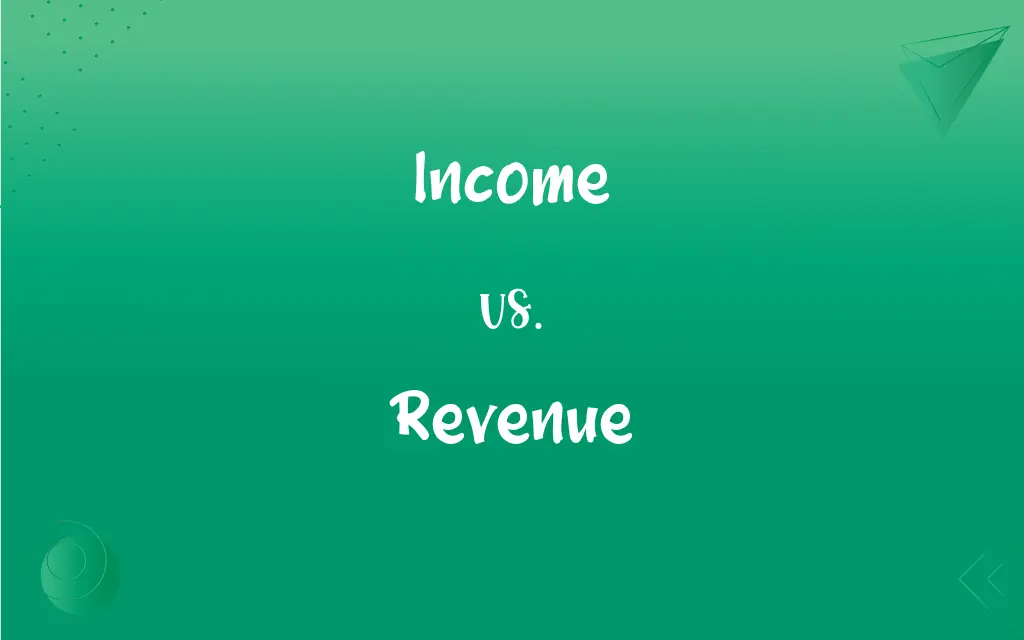Income vs. Revenue: What's the Difference?
Edited by Aimie Carlson || By Harlon Moss || Updated on October 25, 2023
Income is the profit made after deducting expenses, while revenue is the total amount earned before expenses.

Key Differences
Income and revenue are financial terms frequently used in the world of business, accounting, and finance. Revenue refers to the total amount of money brought into a company from its primary operations, such as sales of products or services. It represents the gross earnings and is often termed as the "top line." Income, on the other hand, is what remains after all business expenses, taxes, and deductions are subtracted from revenue. It represents the net earnings or profit, and is sometimes referred to as the "bottom line."
While both income and revenue provide insights into a company's financial health, they serve distinct purposes. Revenue gives a general overview of the sales performance and overall demand for a company's offerings. In contrast, income provides a more comprehensive look at profitability, reflecting the company's efficiency in managing its operations and expenses. Thus, it's entirely possible for a company to have high revenue but low income if its costs are too high.
Another key distinction between income and revenue lies in their respective compositions. Revenue is typically generated from primary business activities. For example, for a retailer, revenue comes from the sale of goods. For a service provider, revenue comes from the provision of services. Income, however, takes into account other earnings too, such as investments or secondary business activities, as long as expenses related to them are accounted for.
It's essential to understand the nuances between income and revenue when analyzing or comparing businesses. For instance, a company with substantial revenue growth might seem appealing, but if its income isn't increasing at a similar rate or is declining, it might indicate underlying operational inefficiencies or rising costs. Similarly, steady or growing income despite stable or decreasing revenue might suggest that a company is effective at cost control or has diversified sources of earnings.
Comparison Chart
Definition
Net earnings after all expenses.
Total earnings from primary operations.
ADVERTISEMENT
Reflects
Profitability.
Sales performance.
Composition
Can include earnings from secondary activities.
Primarily from main business activities.
Also known as
Bottom line.
Top line.
Impact of Expenses
Takes expenses into account.
Does not deduct expenses.
Income and Revenue Definitions
Income
Net earnings after expenses.
After deducting operational costs, the company reported a positive income.
ADVERTISEMENT
Revenue
Gross income from primary operations.
Despite challenges, they maintained steady revenue throughout the year.
Income
Amount remaining post-deductions.
After considering the overheads, the startup's income was surprisingly robust.
Revenue
Overall business intake before expenses.
New product lines significantly boosted the revenue.
Income
Financial gain over a period.
Quarterly reports revealed a steady rise in income.
Revenue
Money received from sales or services.
This quarter's revenue was the highest in the past three years.
Income
The net monetary gain.
The income statement showed promising figures, indicating growth.
Revenue
Financial influx from primary activities.
The annual report highlighted consistent revenue growth.
Income
Profit from business operations.
Their main goal is to increase their annual income.
Revenue
Total earnings before deductions.
The company's revenue exceeded expectations due to increased sales.
Income
The amount of money or its equivalent received during a period of time in exchange for labor or services, from the sale of goods or property, or as profit from financial investments.
Revenue
The income of a government from all sources appropriated for the payment of the public expenses.
FAQs
Which is a better indicator of financial health: income or revenue?
Both provide insights; revenue indicates sales performance, while income reflects profitability after expenses.
What does income represent in business?
Income represents the net earnings or profit after all expenses are deducted from revenue.
What's the relation between gross profit and revenue?
Gross profit is what remains after deducting the cost of goods sold (COGS) from revenue.
How do secondary business activities impact income?
Income can include earnings from secondary activities, provided related expenses are deducted.
How do investors view income and revenue?
Investors often look at both; revenue indicates growth potential, while income reflects operational efficiency and profitability.
Do startups often have a closer gap between income and revenue?
Many startups initially have a narrow gap or even negative income due to initial expenses and investments outpacing revenue.
How do one-time expenses or windfalls affect income?
One-time expenses can decrease, and windfalls can increase net income for that specific period.
What happens when expenses exceed revenue?
When expenses surpass revenue, a company reports a negative income or a net loss.
Is income affected by taxation?
Yes, taxes are one of the deductions considered when calculating net income.
Can a company boost its income without increasing revenue?
Yes, by reducing expenses or diversifying earnings sources, a company can increase its income without raising revenue.
Are there industries where the difference between income and revenue is particularly notable?
Yes, in industries with high operational costs, the difference between revenue and income can be substantial.
Which financial statement provides details on income and revenue?
The income statement provides details on both income and revenue.
How do companies aim to bridge the gap between revenue and income?
Companies often aim to reduce costs, improve operational efficiencies, or diversify income sources to bridge this gap.
How is revenue different from sales?
While often used interchangeably, revenue is the total earnings, while sales specifically refer to earnings from sold goods or services.
Is income always a positive figure?
No, if expenses exceed revenue, a company will report a negative income or loss.
Why is revenue called the "top line"?
Revenue is the first line on an income statement, reflecting total earnings before any deductions.
Can a company have high revenue but low income?
Yes, if a company has high operational costs or expenses, it can have high revenue but low income.
Can revenue be zero?
Yes, if a business has no sales or services provided in a period, revenue can be zero.
Can both income and revenue be negative figures?
While revenue typically isn't negative, income can be if expenses exceed revenue.
Can revenue give insights into market demand?
Yes, revenue can indicate the demand for a company's offerings or services in the market.
About Author
Written by
Harlon MossHarlon is a seasoned quality moderator and accomplished content writer for Difference Wiki. An alumnus of the prestigious University of California, he earned his degree in Computer Science. Leveraging his academic background, Harlon brings a meticulous and informed perspective to his work, ensuring content accuracy and excellence.
Edited by
Aimie CarlsonAimie Carlson, holding a master's degree in English literature, is a fervent English language enthusiast. She lends her writing talents to Difference Wiki, a prominent website that specializes in comparisons, offering readers insightful analyses that both captivate and inform.































































